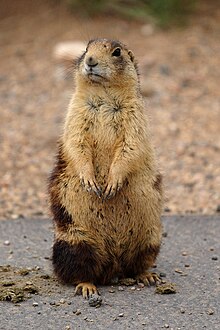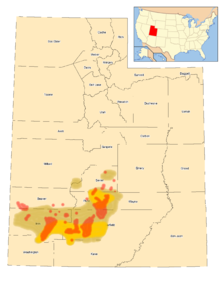Utah prairie dog
| Utah prairie dog | |
|---|---|
 |
|
| Scientific classification | |
| Kingdom: | Animalia |
| Phylum: | Chordata |
| Class: | Mammalia |
| Order: | Rodentia |
| Family: | Sciuridae |
| Genus: | Cynomys |
| Species: | C. parvidens |
| Binomial name | |
|
Cynomys parvidens Allen, 1905 |
|
 |
|
| Utah prairie dog range in 1920 (ochre), 1970 (yellow) and 1991 (red) | |
The Utah prairie dog (Cynomys parvidens) is the smallest species of prairie dog, a member of the squirrel family of rodents native to the south central steppes of the US state of Utah.
The fur is multicolor, which consists of black, brown, and dark brown at the tip. Face have dark brown cheeks and whitish tone of chins and mouth.
The total body length of typical adult ranges from 30.5 cm to 36.0 cm with 3 cm to 6 cm of tail. Adult prairie dogs weigh about 0.77 kg to 1.41 kg in males, and 0.64 kg to 1.13 kg in females. Utah prairie dogs show sexual dimorphism that males are 27% bigger than female, although the ratio varies by season. In 1952, Durant noted that Utah prairie dogs have larger in every aspect of skull than that of Gunnison's prairie dog.
Utah prairie dogs prefer swale land area with abundant herbaceous plants. They build burrows on soils with adequate drain ability, and depth to protect themselves from predators and other environmental factors such as temperature. Utah prairie dogs are only found in the southern part of Utah; today they are only found in the central and southwestern part of Utah in Beaver, Garfield, Iron, Kane, Piute, Sevier, and Wayne Counties. However, it was recorded that Utah prairie dogs existed as far north as Nephi, and south to Bryce Canyon National Park, and Aquarius Plateau to the east in 1920, but the number declined from the 1920s to 1970s by 87%, and this was thought due to human settlers who caused overgrazing of soil, thus catalyzed the invasion of shrub to the grass land.
...
Wikipedia

